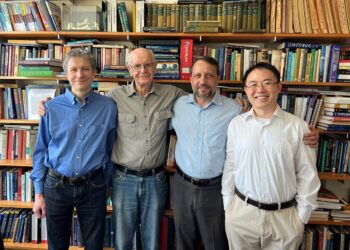Texas A&M Institute Part Of National Effort To Harness Nuclear Laser Fusion For Limitless Energy

Nuclear fusion, the process that powers the sun, is the ultimate source of energy for all life on Earth. On the sun, deuterium and tritium nuclei combine to produce an alpha particle (the nucleus of a helium atom) and a neutron. The dream is to do the same down here, on Earth, in a controlled manner.
It’s for good reason that harnessing fusion energy is one of the greatest scientific and technological challenges of the 21st century. Fusion requires the fuel to be heated to more than 100 million degrees (10 times hotter than the core of the sun). Practical fusion energy also requires that the burning fuel is kept at these hot temperatures long enough so that energy produced by fusion exceeds the energy required to initiate and sustain the fusion reactions.
One of the two most investigated and promising approaches, Inertial Fusion Energy (IFE), uses powerful lasers, which are fundamental tools in IFE research, to heat a small target containing fusible material. For the first time in history last winter, scientists at Lawrence Livermore National Laboratory’s Ignition Facility achieved a critical milestone in the development of IFE by demonstrating a net target gain with the fusion energy output exceeding the laser energy input on the way to making commercial fusion a success.

On the heels of announcing a $45 million program for IFE fusion energy development in May, the U.S. Department of Energy today (Dec. 7) unveiled a $42 million program establishing three new hubs to advance foundational IFE science and technology. Texas A&M’s Institute for Quantum Science and Engineering (IQSE) is a major player in one of the multi-million-dollar hubs, known as RISE, which will be led by Colorado State University and dedicated to advancing laser-driven fusion energy.
“The RISE hub will become a center of excellence for IFE science and technology to support the DOE’s mission in IFE,” said Dr. Marlan Scully, a University Distinguished Professor and IQSE director.
The DOE investments in IFE science and technology will enable RISE hub researchers to build on the momentum of that 2022 Livermore Lab breakthrough. The RISE hub brings together leading institutions in the U.S. and innovative private fusion companies, along with their unique complementary skills, to synergistically work together to achieve scientific milestones in making fusion energy a commercial reality and to grow the much-needed diverse workforce in fusion.
Researchers from IQSE are joined by scientists and engineers from University of Illinois, Cornell University, Colorado State University, the DOE’s SLAC National Accelerator Laboratory, Los Alamos National Laboratory, the Naval Research Laboratory and three companies: Marvel Fusion, Xcimer Energy and General Atomics.
“The IQSE was built by the visionary Chancellor’s Research Initiative program started by [Texas A&M University System] Chancellor John Sharp,” said Dr. Alexei Sokolov, a professor in the Department of Physics and Astronomy and IQSE associate director. “We look forward to bringing the IQSE expertise in exotic laser physics to bear on the laser-fusion promise.”
The RISE hub is funded by the DOE’s Office of Science, Fusion Energy Science through the DOE’s Inertial Fusion Energy Science and Technology Accelerator Research (IFE-STAR). The RISE hub will combine innovative target concepts with new developments in excimer gas lasers and solid-state laser drivers to open up novel IFE regimes. The hub will also prioritize the involvement of students and workforce development, and university-industry-national laboratory collaborations.
To learn more about research in quantum science and engineering at Texas A&M or the RISE hub, visit iqse.tamu.edu.
Media contact: Shana K. Hutchins, shutchins@tamu.edu





